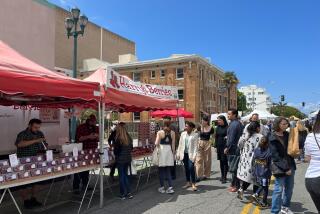Market Watch: The sweet smell of Mara des Bois strawberries
Walking through the Santa Monica farmers market early one recent morning, I noticed Sherry Yard, executive pastry chef of Spago, carrying a flat of strawberries that looked oddly different than any I had seen there before. Even from 10 feet away, they seemed smaller and rounder than conventional strawberries, with prominent seeds and an unusual carmine-orange color. As I wondered what they might be, suddenly the breeze shifted my way, wafting an intense aroma of wild strawberries, and I knew.
“They’re …” I started to say, my mouth agape, hardly believing.
“… Mara des Bois!” said Yard in the exultant tone of one who has just scored.
From the name, one might think that Mara des Bois is a variety of wild strawberry, called fraises des bois in French, or perhaps a hybrid of wild and garden strawberry, given that its size is between the two. Actually, it’s a pure garden strawberry, an extraordinarily skillful or lucky combination of four older European strawberry varieties (Gento, Ostara, Red Gauntlet and Korona) bred at the Marionnet nursery in France more than 20 years ago. (Because of a genetic mismatch, it’s very difficult to cross wild and garden strawberries, although a few breeders have managed to do so through ingenious strategies.)
Mara des Bois is small and soft compared with modern commercial strawberries like Albion but much larger and firmer than true wild strawberries, which are typically smaller than a pinkie nail and go from unripe to mushy in a blink. Somehow, miraculously, the Marionnets came up with a berry richly imbued with methyl anthranilate, the volatile compound that gives fraises des bois their alluring perfume. The aroma reminds some people of romance (“Wild strawberries only seven francs a kilo,” Tony Bennett sang), others of Pez candy, Kool-Aid, or bubblegum.
Mara des Bois is grown commercially on a considerable scale in France, where it fetches a premium for its exceptional quality. Chino Nojo, a famously secretive high-end farm in Rancho Santa Fe, near San Diego, has sold the berries since the 1990s, and David Chelf of Wicked Wilds grew them for a few years in remote Ranchita. A few commercial farmers tried growing Mara, but its shelf life, about five days, is well short of the 10 days needed for cross-country shipment.
That’s enough for local sales, but despite its exceptional taste quality, Mara remained unaccountably neglected at Southern California farmers markets. Most farmers just didn’t know about it, and the plants were hard to get.
Then, several years ago, Glenn Gaeckle of Princeton Avenue Growers in Berkeley Heights, N.J., read an article about Mara des Bois and became so excited that he took over as the United States representative for Marionnet. He got highly reputed Nourse Farms to grow the plants, and in the last two years sales of Mara des Bois have increased greatly, to some 100,000 plants this season, said Gaeckle. The variety is now widely available to home gardeners from retail nurseries such as White Flower Farm, Burpee, the Strawberry Store, and Wayside Gardens. The plant patent for Mara des Bois expires in September, so it seems likely that the variety’s popularity will continue to increase.
Mara des Bois is most ideally grown in a home garden, where, as an everbearer, it produces over a long season, and the berries can be harvested fully ripe. Most of the aroma and other complex flavors that make this variety so remarkable develop only with full ripeness. However, there are times when, either because of cool, cloudy weather or the inherent vegetative cycles of the plant, the flavor does not live up to the raves of aficionados; that’s true, to a greater or lesser extent, for all strawberries. But at its best, Mara des Bois is extraordinary.
Randy Pudwill, whose Pudwill Berry Farms grows a great variety of specialty berries in Nipomo and sells at more than a dozen farmers markets in Southern California, had long been intrigued with reports of Mara, and this year he put in several thousand plants. He started harvesting two weeks ago, just three or four flats per picking, which he has been selling at the Santa Monica Wednesday and Saturday markets. The berries’ aroma is a powerful advertisement, and chefs and specialty produce purveyors have been hounding him and his wife, Pyongyun (“Py”), to sell them the prized fruit, but even steady customers such as Yard are on a strict allocation.
“I’ll blow through these at one lunch,” said Yard, cradling a half-flat of the precious berries on Wednesday. She planned to use them in a honey nougat and in a mille-feuille, she said.
Because Mara des Bois is a new variety for Pudwill, he is not sure what production will be, but he thinks that as it increases more berries will be available to the public and that the season will run into the fall. Currently, he’s selling Mara at $6 for a half-pint.
We’re probably going to be hearing and sniffing more of Mara’s distinctive aroma soon. Nourse is conducting a trial on a new Marionnet variety named Maïka that reputedly incorporates much of Mara’s high quality in a larger, firmer berry. They will distribute it to growers and retail nurseries if it proves successful. (The variety was originally called Mariott, but the hotel company objected, said Gaeckle.)
More to Read
Eat your way across L.A.
Get our weekly Tasting Notes newsletter for reviews, news and more.
You may occasionally receive promotional content from the Los Angeles Times.









